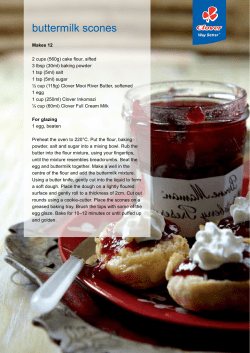
There are many types of packing materials that are available... sturdy packing material is packing peanuts. There are two... Packing Peanuts Activity
Packing Peanuts Activity Suggested Age: 8-10 Time: 30 minutes There are many types of packing materials that are available to use. A useful and sturdy packing material is packing peanuts. There are two types of packing peanuts that can be used: Styrofoam, also known as polystyrene, and Cornstarch. Both Polystyrene and Cornstarch packing peanuts are made from polymers that are long-chain molecules that are made of smaller individual units known as monomers. Even though each of these materials are polymers, there is a large difference between the molecules that make cornstarch and polystyrene. Packing peanuts made from cornstarch are natural polymers or polymers which occur in nature. Polystyrene or Styrofoam peanuts are a synthetic polymer which means that they are man-made. Cornstarch Packing Peanuts Styrofoam Packing Peanuts In the activity we will: • Explore differences between man-made and natural polymers. • Make scientific observations of the behavior of polymers. • Investigate the environmental impacts of degradable and non-degradable polymers. Materials • Two large mixing bowls • 2 cups warm water • Spoon • Styrofoam (polystyrene) peanuts (may use Styrofoam cups or plates which or torn into small pieces) 1 • Cornstarch peanuts – these can be bought (at a moving company such as U-Haul or sometimes Barnes and Nobles will give them to you for no charge). Another alternative is to make cornstarch packing peanuts by using the recipe as follows: Making Cornstarch Packing Peanuts (optional) Note: If time does not permit, use the pre-made cornstarch and read the directions of how cornstarch is made. Then, make the cornstarch packing peanuts starting with step 7. Materials • Package of frozen corn • Mixing bowl • Iodine • Tablespoon and teaspoon • Piece of cheesecloth • Paper cups • Wax paper • Slotted spoon • Potato masher • Stir stick • Water • Styrofoam packing peanut Directions for making cornstarch 1. Thaw a package of frozen corn and place in a bowl. 2. Crunch up the corn with a potato masher until all of the corn pieces are well mashed. Cover the mashed corn with a layer of water. Let stand for 24 hours. 3. Remove from bowl with a slotted spoon and place on waxed paper. Allow water to stand for another 15 minutes. 4. Gently pour off the water through a piece of cheesecloth, allowing the starch to become trapped in the cloth. 5. You can see and feel the starch that is left in the cheesecloth. Use a small portion of the cheesecloth to determine if there is starch left in the cheesecloth by placing the iodine on that portion. If starch is present, the iodine changes from reddishbrown to blue-black. Allow the remainder of the cheesecloth to dry overnight. 6. Once the starch is dry, it will turn into a powder which you can feel and taste. 7. Now, take 1 tablespoon of the corn powder that you made and mix it with 1 teaspoon of water in a paper cup. Stir with a stick until it becomes a workable paste. If you microwave the mixture on high for 15 seconds, it will provide a more consistent product for examination. You have made a bio-degradable packing peanut. Activity 2 From the recipe, did you notice anything a similarity about the ingredients for cornstarch packing peanuts? All of these ingredients are edible! Since cornstarch packing peanuts are made from cornstarch (which is made from corn) they are edible. Cornstarch packing peanuts were actually invented to be a brand of cereal. However, the taste did not appeal to many people so they were used as packing materials instead. Try one to see if you like the taste. Now, study the cornstarch packing peanut next to a Styrofoam packing peanut and compare qualities. What are some of the characteristics? Similarities? Differences? Next, get your mixing bowls. In the first mixing bowl, add 3 handfuls of Styrofoam peanuts, in the second mixing bowl, add 3 handfuls of cornstarch packing peanuts. Place Styrofoam packing peanuts in one mixing bowl and cornstarch packing peanuts in another mixing bowl. Next, in each mixing bowl, add one cup of warm water and describe what happens to each of the packing materials. 3 Slowly add water to both the cornstarch and Styrofoam packing peanuts. • • • • • How does each type of peanut behave in water? Do any of the peanuts dissolve in water? If so, what happens to these peanuts as they dissolve? How fast did they dissolve? Put some cornstarch packing peanuts in water again and time how fast they dissolve. How long did it take? _____________ Discovery Before you added the water, 3 handfuls of Styrofoam peanuts equaled about 3 handfuls of cornstarch peanuts. • After the water was added, which of the packing materials took up more space? What would be the advantages of replacing all Styrofoam packing peanuts with cornstarch based peanuts? • Would it be practical to replace all the Styrofoam used for Styrofoam cups and picnic plates with the cornstarch material used in some packing peanuts? Why or why not? 4 From the activity, you saw that cornstarch packing peanuts break down easily when water was added to them. How is this beneficial to the environment? Cornstarch has come a long way from when it was first developed and it may be possible to develop more useful and environmentally friendly cornstarch products in the future. However, which is a better packing material? Packing Materials Experiment How do polystyrene and cornstarch packing peanuts hold up as packing materials? Test them by packing a cardboard box with an egg. Then, drop the box from different heights to see how well each of the packing materials protects the item. Before you begin your experiment, form a hypothesis of what you think the more durable packing material is. Materials • Eggs • Cornstarch packing peanuts • Styrofoam packing peanuts • 1-2 Small cardboard boxes, milk or juice containers • plastic baggies Prepare the egg: 1. Pack the cardboard box, milk or juice carton half full with the packing materials. 2. Secure the egg in a plastic bag and place in the middle of the packing materials. Finish packing the rest of the box with the packing materials. 3. Once the egg is inside of the packing materials, close the cardboard box and use masking tape to close the open flap of the box. Test each packing material: 1. Using the data sheet below, record the results of your egg experiment whether or not the egg broke. 2. Drop the cardboard box from 1 foot. Open the box and find the egg, record the results (egg is broke or still in tact). If the egg is broken, replace it with a new egg and continue testing. 3. Repeat 2 additional trials. 4. Drop the cardboard box from 4 feet. Open the box and find the egg, record the results (egg is broke or still in tact). If the egg is broken, replace it with a new egg and continue testing. 5. Repeat 2 additional trials. 6. Drop the cardboard box from 8 feet. This may be done outside. Open the box and find the egg, record the results (egg is broke or still in tact). If the egg is broken, replace it with a new egg and continue testing. 7. Repeat 2 additional trials 5 Packing Materials Data Sheet Packing Material Height=1 foot Height=2 feet Height=4feet Egg broken (Yes/No) Egg broken (Yes/No) Egg broken (Yes/No) Styrofoam Trial 1 Trial 2 Trial 3 Cornstarch Trial 1 Trial 2 Trial 3 Results and Conclusions Based on the evidence, which packing material do you think is more durable? Count up the total number of egg breakages using the Styrofoam packing peanuts and place it here. ______________ Count up the total number of egg breakages using the Cornstarch packing peanuts and place it here. ______________ Are these packing materials much different or are they similar? Which packing material would you recommend shipping companies to use and why would you recommend it? Extension Activity 1. Using the following timeline of the history of cornstarch, develop an idea for a future cornstarch product. History of cornstarch a. Cornstarch was invented in 1840 by Thomas Kingsford, while he was working as the superintendent of a wheat starch factory in Jersey City, New Jersey. Until 1850, cornstarch was used primarily for starching laundry and industrial uses. b. Cornstarch is fine, powdery flour ground from the endosperm of corn. It's used as a tasteless thickening agent, and to give baked goods a finer and 6 more compact texture. It is often used for thickening sauces, as it is translucent (when mixed into the sauce), not opaque. c. When using corn starch, first mix it with cold water (or other liquid) until it forms a smooth paste, and then add it too whatever you're thickening. If you add it directly into the mix it may form lumps. d. Outside of North America, cornstarch is known as cornflour. This should not be confused with cornmeal, which is a thicker, coarser type of ground corn (it uses the whole corn kernel), and cannot replace cornstarch in your recipes. e. The first biodegradable plastics developed from cornstarch in the 1990s are just some of the accomplishments listed in the timeline. 2. Break down polystyrene packing peanuts. This is possible to do with acetone (nail polish remover). However, it is important not to breathe in the acetone and this experiment is best done outside. Place the polystyrene packing peanuts into the acetone and describe what happens to the acetone. Does it look the same as when we added water to cornstarch packing peanuts? Do the polystyrene packing peanuts take a different amount of time to dissolve? 3. Are there any setbacks to using cornstarch packing peanuts? As mentioned earlier, cornstarch packing peanuts are edible. Can you think of any reason why this could be bad for businesses using cornstarch packing peanuts? 4. What would happen if you bury each of these packing peanuts in the ground? Make a prediction and then bury both of them in the dirt (about 3 or 4 inches underground). Mark the ground where each of them is buried. In two weeks, dig them out of the ground and describe their appearance. 7
© Copyright 2025









